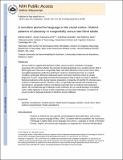A sensitive period for language in the visual cortex: Distinct patterns of plasticity in congenitally versus late blind adults
Author(s)
Bedny, Marina; Pascual-Leone, Alvaro; Dravida, Swethasri; Saxe, Rebecca R.
DownloadSaxe_A sensitive period.pdf (1.226Mb)
PUBLISHER_CC
Publisher with Creative Commons License
Creative Commons Attribution
Terms of use
Metadata
Show full item recordAbstract
Recent evidence suggests that blindness enables visual circuits to contribute to language processing. We examined whether this dramatic functional plasticity has a sensitive period. BOLD fMRI signal was measured in congenitally blind, late blind (blindness onset 9-years-old or later) and sighted participants while they performed a sentence comprehension task. In a control condition, participants listened to backwards speech and made match/non-match to sample judgments. In both congenitally and late blind participants BOLD signal increased in bilateral foveal-pericalcarine cortex during response preparation, irrespective of whether the stimulus was a sentence or backwards speech. However, left occipital areas (pericalcarine, extrastriate, fusiform and lateral) responded more to sentences than backwards speech only in congenitally blind people. We conclude that age of blindness onset constrains the non-visual functions of occipital cortex: while plasticity is present in both congenitally and late blind individuals, recruitment of visual circuits for language depends on blindness during childhood.
Date issued
2011-12Department
Massachusetts Institute of Technology. Department of Brain and Cognitive SciencesJournal
Brain and Language
Publisher
Elsevier
Citation
Bedny, Marina, Alvaro Pascual-Leone, Swethasri Dravida, and Rebecca Saxe. “A Sensitive Period for Language in the Visual Cortex: Distinct Patterns of Plasticity in Congenitally Versus Late Blind Adults.” Brain and Language 122, no. 3 (September 2012): 162–170.
Version: Author's final manuscript
ISSN
0093934X